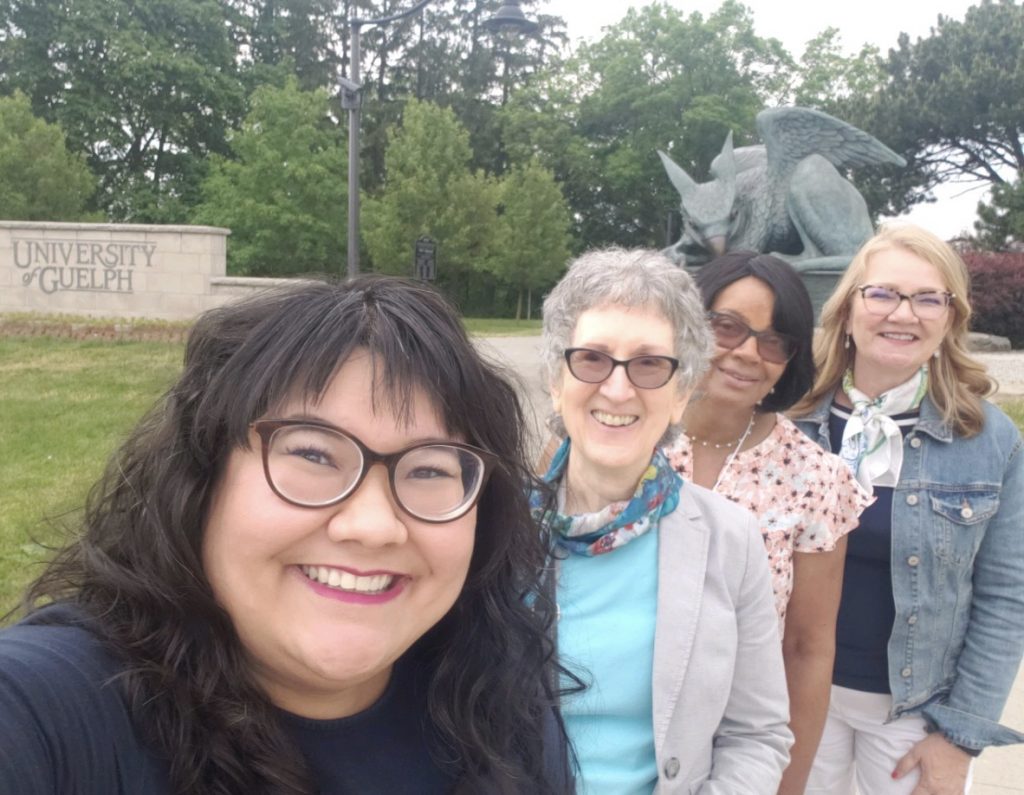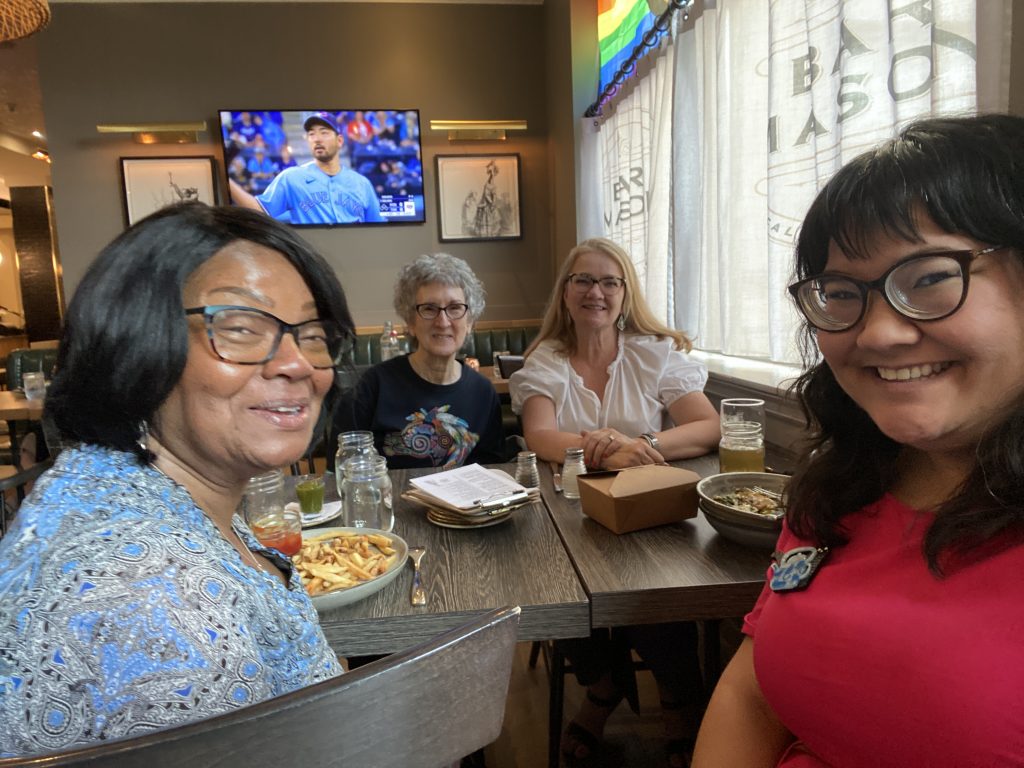Tags
BGSU History, Childhood Conference, Dr. Christine Eisel, Dr. Lisa Rose Lamson, Dr. Ruth Wallis Herndon, Dr. Shirley Green, Emeriti, University of Guelph
By Professor Emerita Ruth Wallis Herndon, Ph.D.

Four historians, all alumnae of BGSU’s Department of History, made presentations and renewed collegial ties earlier this month at a conference organized by the Society for the History of Children and Youth (SHCY) and hosted by the University of Guelph in southern Ontario.
The four are:
- Dr. Ruth Wallis Herndon, professor emerita after teaching at BGSU for fifteen years, 2007-2022. She had the privilege of directing the graduate projects of Eisel, Green, and Lamson during their graduate work at BGSU.
- Dr. Christine Eisel, 2012 PhD from BGSU. She is Associate Professor of Teaching at the University of Memphis.
- Dr. Shirley Green, 2012 PhD from BGSU. She is Director of the Toledo Police Museum and she teaches courses at BGSU and the University of Toledo.
- Dr. Lisa Rose Lamson, 2014 M.A. from BGSU. She received her PhD in 2021 from Marquette University and is now Assistant Teaching Professor at the University of Wisconsin-Green Bay.

Dr. Eisel, Dr. Green, and Dr. Herndon presented papers at a session on the first day of the international conference, June 8, 2023: “Children and Parents in the Revolutionary Era: Beneficiaries of Revolution?” Dr. Eisel’s paper was “Mothers and Orphans: Women and Guardianship in Early Virginia.” Dr. Green’s paper was “Being a Man, Being a Father: Fathers and Children of the First Rhode Island Regiment.” Dr. Herndon’s paper was “Children of Color as Boston’s Pauper Apprentices Before and After the Revolution.” Together, these papers asked whether American Revolutionary ideas changed parent-child relationships. The authors showed how inequality affected children, despite the revolutionary rhetoric on liberty and equality.
Dr. Lisa Wilson, Professor Emerita at Connecticut College and author of A History of Stepfamilies in Early America (University of North Carolina Press, 2014) and several other books on families in early America, prepared the comment. She delivered her remarks via Zoom, as she was unable to attend the conference in person. Dr. Wilson praised the panelists for their “painstaking historical work” that has “unearthed some remarkable stories,” demonstrating the power of primary source material to “elevate new voices from the past.” She pointed out that the people studied in these papers were navigating a system designed to oppress them because of their race, gender, or economic status.
Dr. Eisel has worked extensively on the social and legal power of women’s speech in southeastern Virginia in the seventeenth century. She has published several book chapters, including “‘They make one very handsome Mirkin amongst them’: Gossip and Church Politics in Early York County, Virginia,” in an anthology published by Palgrave MacMillan in 2014, When Private Talk Goes Public: Gossip in American History. For the SHCY conference paper, she carried her research forward to show how women used the law to advocate for their children when their fathers died during the Revolutionary Era. These women still had to fight in court to be recognized as guardians of their orphaned children and protectors of their inheritances. “This paper pushed me out of the seventeenth century,” Eisel said. “It made me think about women’s interaction in the legal system beyond what I was already studying. Pushing it into the eighteenth century shows the sustained trajectory of women’s knowledge and experience with the legal system.”
Dr. Green’s extensive research on Rhode Island veterans is showcased in her forthcoming book from Westholme Press: Revolutionary Blacks: Discovering the Franck Brothers, Freeborn Men of Color, Soldiers of Independence. Her SHCY paper pushed her research in a new direction, showing that Rhode Island veterans of color returned home to communities where they frequently struggled to support their children economically and socially. Green said that doing this paper helped her expand her vision. “I’ve always looked at the Revolutionary War from the perspective of soldiering, especially soldiers of color. This paper helped me look at the war from the perspective of the family and ask how it affected the children. Did the soldiers’ children reap any benefits from their father’s service? Did the children follow in their fathers’ footsteps during the War of 1812?”
Dr. Herndon’s SHCY paper was drawn from her current book project, “Children of Misfortune: The Fates of Boston’s Poor Apprentices.” This is a sequel to the study she co-authored and co-edited with John E. Murray, Children Bound to Labor: The Pauper Apprentice System in Early America (Cornell, 2009). Herndon’s conference paper showed how Boston magistrates began to bind out children of color to white masters in the 1780s, as slavery declined in the region after the war. Pauper apprenticeship gave white residents a sense of stability by mimicking slavery; it stopped the free movement of children of color and put them to work in local households. “This paper helped me understand how pauper apprenticeship changed during the Revolutionary Era,” Herndon said. “The war prompted changes in slavery, which in turn prompted changes in magistrates’ attitudes towards children whose parents had been enslaved.”
The three panelists had a happy reunion with Dr. Lisa Rose Lamson at the conference. Dr. Lamson was part of a roundtable on the second day of the conference, June 9, 2023: “Teaching Childhood & Youth History.” She also presented a paper that same day at a session on “Diverse Insights from School Records & Curriculum”. Lamson’s paper built on her dissertation research on the education of children of color in Baltimore in the nineteenth century. Her paper was titled: “Objects of Education: Curricular Reform and ‘Object lessons’ in Baltimore City’s Colored Public Schools.” “The conference gave me a welcome opportunity to get back to my research,” Lamson said. “Also, it was nice to engage in face-to-face conversation, which doesn’t happen at a digital conference.”
These four BGSU historians have stayed in contact over the years, but this is the first time they were all together in the same place since Lisa Rose left BGSU after completing two Master’s degrees in History and Education. While at the University of Guelph, they walked the beautiful campus (despite the slightly smoky air from distant wildfires), attended sessions together, and shared meals. “We have all sustained our scholarly energy and maintained our scholarly network,” said Herndon. “Thanks to BGSU and SHCY, we had the opportunity to see each other, talk about our work, and encourage each other professionally and personally. It was a wonderful meeting.”

